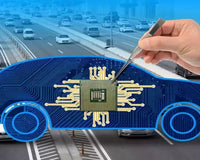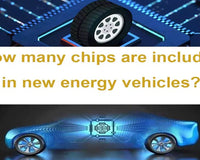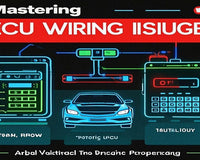In the fast evolving landscape of new energy vehicles (NEVs), the question of “how many chips are included in new energy vehicles?” is not just a matter of numbers but a key to understanding the technological prowess driving this industry forward. The number of new energy chips can vary significantly based on the vehicle's design, complexity, and features. Generally, an EV is expected to contain a higher number of semiconductor chips compared to traditional internal combustion engine (ICE) vehicles.
For average electric vehicles, estimates suggest that they can contain upwards of 3,000 semiconductor chips. In contrast, a typical ICE vehicle might have around 1,500 chips. This increasing chip count in EVs reflects the advanced technologies utilized in areas such as battery management systems, infotainment, and advanced driver-assistance systems (ADAS).
The Multifaceted Roles of Chips in NEVs.
Powertrain Management.
At the heart of an NEV is its powertrain, and this is where a significant number of chips come into play. For electric vehicles (EVs), the battery management system (BMS) is crucial. A typical BMS can contain around 10 - 20 integrated circuits (ICs) or chips. Power Management chips monitor and control various aspects such as battery voltage, current, and temperature. They ensure that the battery operates within a safe and efficient range, maximizing its lifespan and performance. In addition, the inverter, which converts DC power from the battery to AC power for the electric motor, is also packed with chips. High performance power chips are used to handle the high voltage and high current requirements, with an inverter often having 5 - 10 specialized chips.
Autopilot and ADAS Systems.
Advanced driver assistance systems (ADAS) and autopilot features are becoming increasingly common in NEVs. These systems rely on a vast array of chips. A modern ADAS suite may use around 20 - 30 different chips. Radar sensors use specialized radar chips to detect the distance, speed, and angle of surrounding objects. Lidar systems, which are also integral to higher - level autonomous driving, have their own set of chips for processing the light based data they collect. For example, some lidar units contain custom designed chips for fast data conversion and processing. Moreover, the central processing unit (CPU) and graphics processing unit (GPU) that handle the overall decision making for ADAS and autopilot functions are complex chips. High - end vehicles with advanced autopilot capabilities may have CPUs and GPUs that are equivalent to or even more powerful than those in high performance desktop computers, and these single chips are often accompanied by multiple supporting chips for tasks like memory management and data transfer.
Infotainment and Connectivity.
The in - car infotainment and connectivity systems of NEVs also contribute significantly to the chip count. A modern infotainment system might include 15 - 20 chips. These chips are responsible for functions such as running the vehicle's operating system, powering the touchscreen display, handling audio and video playback, and enabling wireless connectivity features like Bluetooth and WiFi. Additionally, with the rise of vehicle to everything (V2X) communication, new chips are being integrated to facilitate communication between the vehicle and other vehicles, infrastructure, and even mobile devices. These V2X chips add another 3 - 5 chips to the overall count in a connected NEV.
So, how many chips are in a new energy vehicle in total? The number can vary widely depending on the vehicle's make, model, and level of technological sophistication. For a basic entry level NEV with minimal ADAS features and a simple infotainment system, the chip count could be around 50 - 80 chips. However, for a high end luxury NEV with advanced autopilot capabilities, a state of the art infotainment system, and comprehensive connectivity features, the number can easily exceed 300 chips. Some of the most technologically advanced concept vehicles in development are rumored to have even higher chip counts, as they push the boundaries of what is possible in terms of autonomous driving, in car experience, and vehicle to grid integration.
In conclusion, chips are the invisible workhorses that power the innovation in new energy vehicles. As the industry continues to grow and evolve, with more features being added and performance being optimized, the number of chips in NEVs will only continue to increase, driving the next wave of automotive transformation. If you want to know the latest new energy chips, you can follow the Chinese ecufixtool store, they continue to update the chip models on the market










